Book Reviews
Book Review Roundup – January 2015
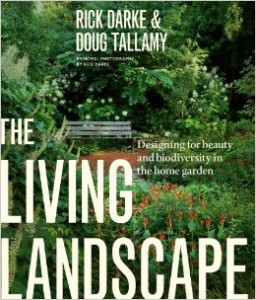 Many wonderful books have come out in the last year. Catch up on one or two during your indoor days. My favorite this year was “The Living Landscape” by Rick Darke and Doug Tallamy. Superb photos matched by insightful writing on how to create or recreate a garden that provides beauty and comfort for the homeowner, a place for the vital wildlife (micro and up) and a chance to make your corner of the world one that aids the environment instead of damaging it.
Many wonderful books have come out in the last year. Catch up on one or two during your indoor days. My favorite this year was “The Living Landscape” by Rick Darke and Doug Tallamy. Superb photos matched by insightful writing on how to create or recreate a garden that provides beauty and comfort for the homeowner, a place for the vital wildlife (micro and up) and a chance to make your corner of the world one that aids the environment instead of damaging it.
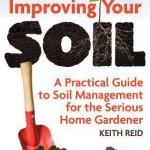 Don’t even think about put a trowel in the ground until you have read one book on soil. “Improving Your Soil” by Keith Reid isn’t a title that promises an exciting read, but for the gardener it’s a must read. Along with old favorite “Teeming with Microbes”, you will be reminded that there is no great garden without great soil. It’s the bacteria, fungi, worms and other creatures we aren’t always thankful for that make our soil great—if we’ll lay off the chemicals and let them.
Don’t even think about put a trowel in the ground until you have read one book on soil. “Improving Your Soil” by Keith Reid isn’t a title that promises an exciting read, but for the gardener it’s a must read. Along with old favorite “Teeming with Microbes”, you will be reminded that there is no great garden without great soil. It’s the bacteria, fungi, worms and other creatures we aren’t always thankful for that make our soil great—if we’ll lay off the chemicals and let them.
Finally, if you always admire the flower arrangements at the Flower Show part of the Boston Flower and Garden show, but don’t think you can arrange 12 roses in a vase, take a look at Judith Blacklock’s “Flower Arranging, a Complete Guide for Beginners” She describes tools, techniques and how to keep flowers alive for more than a few days. Her designs may seem intimidating, but her explanations make them possible for anyone.
Book Review: Gardening for a Lifetime
When I saw that Sydney Eddison had written a book titled, “Gardening for a Lifetime”, I immediately put it at the top of my Christmas list. She didn’t disappoint. If you first encountered Ms. Eddison when she wrote “Gardens to Go” or you finally understood working with color in the garden after reading “The Gardener’s Palette”, you know she has the ability to convey her love of gardens and gardening along with the information you need.
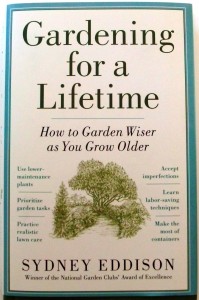 Her latest book is subtitled “How to Garden Wiser as You Grow Older”. But if you are a young gardener with more desire than time or energy to garden, you will find your answers here. The conclusions she comes to and the solutions she recommends should not be saved for the ‘older gardener’. They should be snatched up and relished by everyone who finds that family and work and even other hobbies means that the garden you want is not always the garden you can have. In my garden, I have slowly been coming to many of the same solutions — perennials beds give way to shrubs, for example — they both bloom, they both add beauty to my landscape, but the latter needs significantly less time to maintain.
Her latest book is subtitled “How to Garden Wiser as You Grow Older”. But if you are a young gardener with more desire than time or energy to garden, you will find your answers here. The conclusions she comes to and the solutions she recommends should not be saved for the ‘older gardener’. They should be snatched up and relished by everyone who finds that family and work and even other hobbies means that the garden you want is not always the garden you can have. In my garden, I have slowly been coming to many of the same solutions — perennials beds give way to shrubs, for example — they both bloom, they both add beauty to my landscape, but the latter needs significantly less time to maintain.
Accept change, she advocates, whether it be reducing the size of your garden or the way you garden. Many years ago, the rule was that a good garden required double digging, a back-breaking process of removing and replacing soil in order to add more organic material. Today soil scientists tell you that the process destroys the soils structure and disrupts the microscopic bacteria and fungi that make soil healthy. Double digging is out, top dressing with compost is in.
Her other recommendations may at first seem to verge on heresy. Accept imperfections: nature isn’t perfect, you shouldn’t strive to be either. The American lawn is too much work for too little reward. Rethink why you want or need lawn. Embrace container gardens — they are easier to maintain and can offer you a chance to have a new garden each year. Relish shade and the reduced requirements for maintenance that can come with it.
Sydney Eddison has lectured written and gardened for many years. Now she is distilling what she has learned to help you do the same by making choices to turn gardening from a series of chores back to a source of joy.
* * * * *
A Potpourri of Gardening Titles
When I look at all the books on gardening published each year, I am often overcome by the size, the price, the sheer variety of options. My gardening bookshelves groan under the weight of books that I have read cover to cover (Understanding Perennials, Cullina), of books I dip into for specific information (Dirr’s Hardy Trees and Shrubs) and books I have started and mean to, but have never finished. But there is a series of books, light in weight, easy on the pocketbook and so chocked full of useful information that I find myself going back to them over and over. If you are not acquainted with the Brooklyn Botanic Garden series, go online today and check it out.
The series is the product of numerous authors. It covers everything from vegetable gardening to growing orchids. From Shady Borders to Sunny Borders, Easy Lawns to Houseplants, Bird Gardens to Healthy Soils, the series has something for every gardener.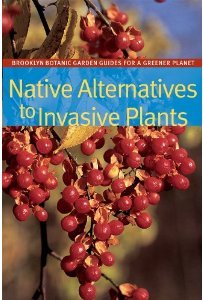
My absolute favorite of the series is Native Alternatives to Invasive Plants. Each invasive is named, its mug shot shown along with it aliases and where it has invaded. Next comes one or several native alternatives with a photo and their natural range. But the authors don’t stop there. They include its hardiness, ornamental attributes and growing tips. In one small paperback book you can find alternatives for invasives both familiar and unusual. The Chaste tree (Vitex) that I babied along for five years is invasive once it reaches Pennsylvania. And while I always thought of Queen Anne’s Lace as a beneficial, I find I should be replacing it with Angelica or Valerian.
The Native Perennials is an excellent companion for someone who wants to add or redo their garden with true natives. Kitchen Gardening and A New Look at Vegetables will offer even the experienced vegetable gardener new ideas and techniques. Gardening Tips, Bonsai, Orchids, landscape design, I bet there’s something you need. And you probably won’t need a bigger bookcase, at least not right away.
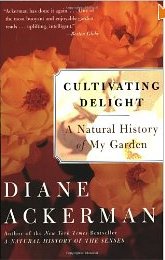 Could I be a good gardener without my favorites plants? Could I get through the winter without the poetical musings of Diane Ackerman, Eleanor Perenyi or Katherine White? The answer to each is yes, but I would be an unhappy gardener without the plants I love and I would find winter less tolerable if I could not see the garden through the eyes of gardeners who are able to translate their love and enthusiasm to the printed page. Diane Ackerman is a poet but she is also a gardener. Her book, Cultivating Delight, celebrates the sensory experiences of the garden. She celebrates the croaking frogs and the tiny one she finds inside a flower. She studies the squirrels despite their depredations to her garden. She expounds on her favorite flower, roses.
Could I be a good gardener without my favorites plants? Could I get through the winter without the poetical musings of Diane Ackerman, Eleanor Perenyi or Katherine White? The answer to each is yes, but I would be an unhappy gardener without the plants I love and I would find winter less tolerable if I could not see the garden through the eyes of gardeners who are able to translate their love and enthusiasm to the printed page. Diane Ackerman is a poet but she is also a gardener. Her book, Cultivating Delight, celebrates the sensory experiences of the garden. She celebrates the croaking frogs and the tiny one she finds inside a flower. She studies the squirrels despite their depredations to her garden. She expounds on her favorite flower, roses.
And even when I disagree, I see the beauty and smell the heady scent through her prose.
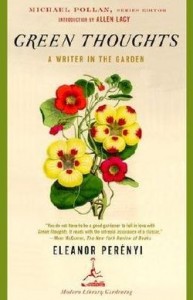 Eleanor Perenyi takes a very different approach in Green Thoughts, a Writer in the Garden. She presents in a series of essays starting with annuals, then artichokes, ashes, asparagus, asters, autumn and azaleas. She cannot limit herself to one entry for most letters of the alphabet, nor does she strain to use every letter. Somehow all these independent musings, opinions and advice flow together to create a story of gardening and her garden. But luckily they read just perfectly where ever the book falls open when you have time for just one. Or maybe two.
Eleanor Perenyi takes a very different approach in Green Thoughts, a Writer in the Garden. She presents in a series of essays starting with annuals, then artichokes, ashes, asparagus, asters, autumn and azaleas. She cannot limit herself to one entry for most letters of the alphabet, nor does she strain to use every letter. Somehow all these independent musings, opinions and advice flow together to create a story of gardening and her garden. But luckily they read just perfectly where ever the book falls open when you have time for just one. Or maybe two.
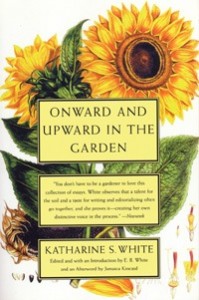 Katherine White believed the act of gardening was the natural thing to occupy one’s spare time. After 34 years as the editor of the New Yorker, she wrote the first of fourteen pieces that would appear in the New Yorker (and later as a book) under the title, Onward and Upward in the Garden. In it she reviews garden catalogs (and finds too much emphasis on change for the sake of change) but praises the owner/writers whose pride and love of their subjects come through. She issues strong views of what flowers should look like (ruffled petunia maybe, ruffled snapdragon, an abomination), where they should be grown (“what was a Southern flower doing in my Maine home”) and her dedication to native plants unmolested by hybridizers. Most of all, she was a see-a-weed-stop-and-pull-it gardener, who relied on her own instincts and gave us beautiful words to carry through to the next growing season.
Katherine White believed the act of gardening was the natural thing to occupy one’s spare time. After 34 years as the editor of the New Yorker, she wrote the first of fourteen pieces that would appear in the New Yorker (and later as a book) under the title, Onward and Upward in the Garden. In it she reviews garden catalogs (and finds too much emphasis on change for the sake of change) but praises the owner/writers whose pride and love of their subjects come through. She issues strong views of what flowers should look like (ruffled petunia maybe, ruffled snapdragon, an abomination), where they should be grown (“what was a Southern flower doing in my Maine home”) and her dedication to native plants unmolested by hybridizers. Most of all, she was a see-a-weed-stop-and-pull-it gardener, who relied on her own instincts and gave us beautiful words to carry through to the next growing season.
* * * * *
Understanding Perennials, or why Bill is a Safe Bet
Most of us are very familiar with Bill Cullina, the former propagator at Garden in the Woods and his wonderful series of books on North American native plants. Starting with Wildflowers; then Native Trees, Shrubs and Vines; and finally Native Ferns, Mosses and Grasses, he has made these plants accessible to the average and advanced gardener. I would call these fabulous reference books but for the fear of scaring away potential readers. There are no dry technical descriptions of the plants and their requirements. Instead he fills his books with lively prose that make you read on after you find the information you initially sought, for the pleasure of reading. A plantsman, with parental urges toward almost every plant he meets, his love of horticulture comes through on page after page.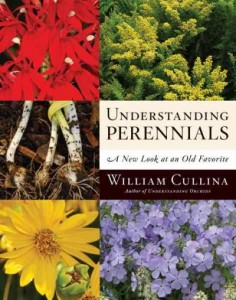
This June, I was presented with a copy of his newest book, Understanding Perennials. As I thumbed through the pages, it was impossible not to be as amused as informed by his succinct essays under titles such as “Why do the Most Expensive Plants Die the Fastest”, “It Takes Two to Tango”, or “Sucking It Up and Spitting It Out”.
Not all the information is new—heck, I’m a MG with a number of decades of gardening experience, a bookcase filled with gardening books and a lengthy list of classes taken from New Hampshire to Virginia. But I have never closed one of his books without the feeling that I have learned something new. In Understanding Perennials, I learned why Lewisa’s are sometimes short-lived, a whole new take on compost teas, and some new advice on dividing my perennials. And despite attending most MG classes at least twice, I found his approach on everything from disease control to soil building offered new and interesting ideals.
If you’ve read his earlier books, you know he is always concerned with how to best propagate any plant. He does not disappoint in his newest book with detailed steps (with photos) for dividing woody crowns or rhizomes, taking soft tissue cuttings, and raising perennials from seed. And in case that’s not enough, he shows you how to hand pollinate to increase seed production. Would that make me their surrogate mother?
Cullina has one more book I’ve not yet read, Understanding Orchids. I don’t doubt for a minute it is as useful and well –written as the others. Like the daffodils that herald each spring and the red peony that always blooms on Memorial Day, some things, and some authors, can be relied on.
* * * * *
Another Potpourri of Gardening Titles
If you’re like me, you don’t get a lot of reading done during gardening season. Certainly there are the early spring days that are too wet or too cold to work in the garden. And you may catch up on your gardening magazines on the summer days that are just too hot (unless that’s the day we’re putting in the Bressingham garden!) But as a rule, I do much of my heavy duty garden reading now. The garden is resting, the house plants need little attention and I can only spend so long with nursery catalogs.
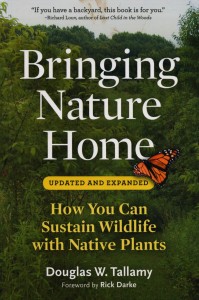 This winter I have finished several books I picked up over the course of the year as well as a new one that arrived under my Christmas tree. The first is “Bringing Nature Home” by Douglas Tallamy. A professor of entomology and wildlife ecology at the University of Delaware he gives the best explanation yet of why we need to plant native—not just for the environment, but for our own well being.
This winter I have finished several books I picked up over the course of the year as well as a new one that arrived under my Christmas tree. The first is “Bringing Nature Home” by Douglas Tallamy. A professor of entomology and wildlife ecology at the University of Delaware he gives the best explanation yet of why we need to plant native—not just for the environment, but for our own well being.
When a nursery brags that no insects will bother a given plant, it is because the plant is an alien species that evolved outside of the regional ecosystem. Our insects cannot survive on the plant (if they can eat it at all). Birds are not nourished by the fruits or seeds and find fewer insects to eat. Compared with our native plants, this newcomer has free rein to grow and spread. And since many native plants rely on the native fauna for their good health—even at the cost of a leaf here and there—the effect multiplies. There are fewer natives to sustain the insects and fewer insects to sustain the flora. Alien species introduced a hundred or more years ago are still not acting as hosts for native insects. Adaption to their exotic chemistry is not a simple matter.
Wonderful color photographs throughout the book help you identify the insects and the plants we need to make our environment thrive, and the ones we need to get rid of. Dr. Tallamy makes recommendation of ways for us to make gradual changes to our yards and gardens to help to reverse the trend of increasing disruptions in the native ecology. He includes lists of the plants we need to incorporate in our garden plans.
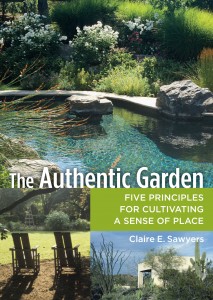 At first glance, Claire Sawyer’s “The Authentic Garden, Five Principles for Cultivating a Sense of Place” might be mistaken for just another landscaping design book. But Ms Sawyer, the director of the Scot Arboretum at Swarthmore College, has taken the stance that the garden must reflect and work within the larger context of local landscape and history. She guides you through the five principles she believes will instill a sense of authenticity to American gardens. While many of her ideas have been inspired by historic garden designs, she feels for too long we have relied on borrowing piecemeal from European and Asian designs. Developing an appreciation of our landscapes and history leads to truly American gardens.
At first glance, Claire Sawyer’s “The Authentic Garden, Five Principles for Cultivating a Sense of Place” might be mistaken for just another landscaping design book. But Ms Sawyer, the director of the Scot Arboretum at Swarthmore College, has taken the stance that the garden must reflect and work within the larger context of local landscape and history. She guides you through the five principles she believes will instill a sense of authenticity to American gardens. While many of her ideas have been inspired by historic garden designs, she feels for too long we have relied on borrowing piecemeal from European and Asian designs. Developing an appreciation of our landscapes and history leads to truly American gardens.
The beautiful and compelling garden photos illustrate how these principles can be implemented. In her final chapter she does an in-depth analysis of three private and four public landscapes that epitomize her concept of authentic gardens. Anyone for a road trip?
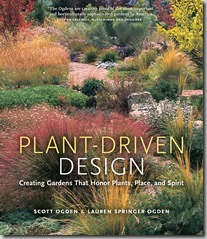 “Plant Driven Design” by Scott Ogden and Lauren Springer Ogden grabs you with the cover subtitle—Creating Gardens that Honor Plants, Place and Spirit. The Ogdens, well known authors and plantsmen, take the “ right plant, right place” mantra a step or three further. They insist that plants must be selected both to thrive on the site and be made the primary focus of the garden. Extensive lists of plants are provided, each adapted to specific site and purposes. They embrace regionality, but transcend it by primarily depending on the choice and placement of plant material to allow each garden to appeal to our emotions.
“Plant Driven Design” by Scott Ogden and Lauren Springer Ogden grabs you with the cover subtitle—Creating Gardens that Honor Plants, Place and Spirit. The Ogdens, well known authors and plantsmen, take the “ right plant, right place” mantra a step or three further. They insist that plants must be selected both to thrive on the site and be made the primary focus of the garden. Extensive lists of plants are provided, each adapted to specific site and purposes. They embrace regionality, but transcend it by primarily depending on the choice and placement of plant material to allow each garden to appeal to our emotions.
Ms Ogden’s photos will make you forget the snow outside your own window. The depictions of admired gardens around the world will convince you that their ideas do make for a lovely landscape.